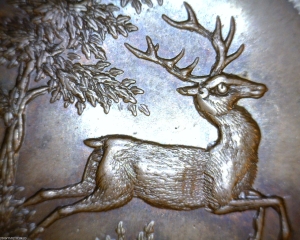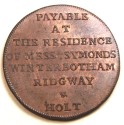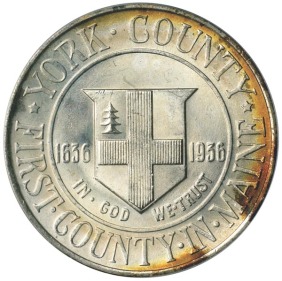Instructors: William Shamhart, Jr., Charles Browne, Lane Brunner, John Dannreuther & John Albanese
Week of July 4, 2009
If you aren’t familiar with the five names above, you should make a concerted effort to find out who they are and where you might meet and learn from their years of experience in numismatics. These gentlemen have a strong background in numismatic research, the marketplace, pricing and “grading” some of the most famous collector coins that have appeared in the market during the last 20-30 years. Of course, these were the gentlemen who taught the ANA’s Advanced United States Coin Grading and Problem Coins class out in Colorado Springs during the second session of this year’s ANA’s summer seminar series.
Bill Shamhart has been teaching advanced grading out at the ANA during the summer seminar series for a number of years and always brings along an “all star” roster of graders, numismatic experts and innovators in the hobby. Of course, Bill heads up the class and is a demanding mentor with the students’ best interest always out front. He is nothing less than a consummate professional whose philosophy is deeply seated in education.
Charles Browne is likewise a most respected PCGS grader and summer instructor with magnificent grading skills and a more than unique ability to explain the subtlety between that PF 66 and PF 67. Charlie also has a very enjoyable personality which enables him to readily share his strong fundamental understanding of market grading and the market place. He also has a mature and profound knowledge of the field of numismatics.
John Albanese, as most of you know, is the president of CAC. He was also one of the co-founders of PCGS and founder of NGC. He is a soft-spoken individual who is easy to engage and discuss grading and answer your questions. He is a man of many interests and seems to be one of the few who are able to see the “big picture” in the “collectibles space”. What an opportunity we had to have him there as an instructor for the week! It was a unique occasion to learn firsthand his insight into creating that little green “CAC” sticker. In addition, we benefited from his one-on-one instruction about grading which was an experience in itself. He was indeed, as they all were, splendid gentlemen with education at the top of their agenda.
Dr. Lane Brunner has served several positions with the ANA. Lane has a sharp and critical eye when it comes to grading high end coins and spotting coins that have problems of every description. His natural teaching skills were evident in our one-on-one examination of coins and explanation of problems that were present on many of the coins.
Finally, there was John Dannreuther, one of the co-founders of PCGS, a well-known world class researcher, author, consultant and rare coin dealer. John was just a wealth of information and enthusiastically shared his personal experiences in the business, as well as, some of his unpublished results regarding the minting process and in particular about proof coinage. His attention to detail during our one-on-one exercises was truly informative. John is currently working on his opus on proof gold coins and gave an excellent lecture on the production of proofs. What a wealth of information!
John, or JD as we learned to call him, rounded out a particularly unique gathering of instructors of exceptional caliber for our one week course.
All of these fellows have been around the business for a while (sorry for that guys), but as I am sure Bill would say……’the truth sometime hurts’. These gentlemen are to be applauded for donating their time and energy so their students will not only be better at grading and detecting problem coins, but will also continue the generous giving of time and energy to numismatics through their example.
These instructors have seen, and in fact, been part of a lot of the change we have all seen during the last twenty years or so in our hobby. Their accomplishments range from the founding of the two most successful grading services and subsequent innovations, such as CAC, participating in numismatic service organizations, publishing articles, reference books and teaching. Finally, they have been successful dealers who have prospered through ethical practices and survived the chaotic markets that occurred during the late 70’s and early 80’s.
From a historical perspective, these gentlemen’s mentors and current colleagues are among the greatest names in 20th century US numismatics. I am sure that in future years, all the students in this class will delight in the fact that they sat in the room with these men for a week and were able to discuss the timely developments of grading, the coin market itself and contemplate the future of our hobby.
Now some comments about the class and its content.
There were twenty five students in the class, including one YN. We had five instructors for almost every exercise we conducted with one-on-one follow-up. The line of attack in the class was simple: we were to look at and evaluate as many coins in 5 days as possible, and then be able to gain a consensus within a group setting about the grade of those coins. I think we saw most US type coins (in copper, silver and gold) and in grades from AU 58 to MS 68 as well as a good number of proof issues.
Not stopping with the grade, you had to determine the method of manufacture (mint state or proof), color designation for copper, other designations such as PL, DMPL, cameo, ultra cameo, FH, FBL, FSBs, FS, as well as, whether the coin had been lightly dipped (and thus graded) or harshly dipped and a “no grade”, cleaning (heavy vs light hairlines), re-colored or doctored to cover scratches or spots….and so own. All the coins were either PCGS or NGC to the best of my recollection.
We broke up into five groups with one instructor assigned to each group. Then the fun began. “Number you papers from one to thirty” came the directive from one of the instructors. Another instructor might tell us that we have 30 seconds to inspect each coin and then must pass it to our neighbor. They reminded us to go with our first impression using only the naked eye and then if you see a problem use your loupe. A loupe was also appropriate for the smaller coins. It seemed as if we were off to the races…and in fact we were!
Coins were passed around the group; you recorded your grade; and after everyone had graded the coins, we begin an in-depth evaluation of the coins. The objective was to arrive at some consensus regarding the grade within the group. All the while, we were getting feedback from our table instructor in the way of questions, comments and tips such as, you might want to look at that coin one more time (since you clearly missed something the first time). The greatest learning tool was in the effort to gain consensus regarding a grade. This was the process that exposed everyones thoughts about the grade of the coins and thus provided the forum for disussion with the each other as well as the instructor.
At first, it was hectic but as that first day progressed I think most of us fell into a rhythm that at least helped everyone get to the second day. Then it started all over again on day two.
We were looking at a lot of different coins and were processing a lot of information in a very short period of time. In the first couple of exercises the grade spread within a given group might be from AU 58 to MS 65 or higher. The objective of the class was to narrow that range down to the correct grade, or to be at least only one point away. Despite the hectic nature of the process the composure and positive instruction from the instructors resulted in little anxiety associated with the process after the first day. We were now on a steep learning curve and had nothing but critical information to gain. This realization, I think, was a big turning point in the class. Now, we had nothing to lose so to speak, but everything to gain. So listen and learn!
As the week progressed, each groups’ consensus grade became tighter and we also gained a much better understanding of A, B and C coins within a grade. This is something John expanded on with regard to certified coins getting those little green “CAC” stickers.
All in all it was a great week and is among the strongest classes I have seen the ANA summer seminar series offer in many years. There were several people that signed up for the class next year before leaving Colorado Springs at the end of the week. That says an awful lot about the instructors and class content. I don’t know of another place where you could gain this type of information from a fine group of experts. I might also mention, there were several students in the class that had taken the class in previous years (as in last year).
If you have the opportunity and are interested in grading ,be sure to look into this class. You must have completed the Beginning and Intermediate grading classes before you can get into this advanced class.
Remember: Eye Appeal and Luster are the two things that your eyes see first when looking at a coin and thus represents that critical first impression. Eye appeal and luster are the top factors being considered in market grading and thus pricing.
We were constantly reminded that with market grading, eye appeal adds a little, but forgives a lot.

Read Full Post »








You must be logged in to post a comment.